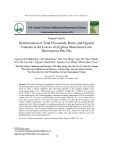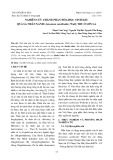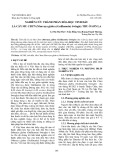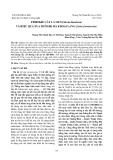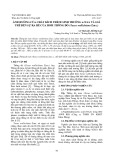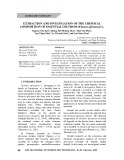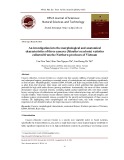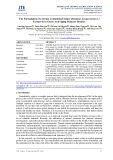
TNU Journal of Science and Technology
230(05): 156 - 161
http://jst.tnu.edu.vn 156 Email: jst@tnu.edu.vn
CHEMICAL COMPOSITION OF ESSENTIAL OIL FROM LEAVES, FRUITS,
AND SEEDS OF THE PARAMICHELIA BAILLONII (PIERRE) S. Y. HU SPECIES
Vu Thi Thu Le1*, Nguyen Thi Hien2, Trinh Xuan Thanh2, Dinh Thi Thu Thuy3, Tran Thi Tuyen3,
Tran Huy Thai3
1TNU - University of Agriculture and Forestry
2Institute of Ecology and Biological Resources - Vietnam Academy of Science and Technology
3Institute of Natural Products Chemistry - Vietnam Academy of Science and Technology
ARTICLE INFO
ABSTRACT
Received:
28/6/2024
The essential oil derived from the leaves, fruits, and seeds of Paramichelia
baillonii, collected in Muong Nhe Nature Reserve, Dien Bien, was obtained
using the steam distillation method with reflux. The oil content in the leaves,
fruits, and seeds of P. baillonii was measured at 0.04%, 0.02%, and 0.13%,
respectively, based on dry air-dried material. Employing gas chromatography-
mass spectrometry (GC/MSD), 61 compounds identified in the leaf essential
oil constituted 97.22% of the total oil content. The primary constituents of the
leaf oil included β-caryophyllene (22.47%), α-humulene (6.88%), β-selinene
(9.91%), and α-selinene (7.30%). In the essential oil from P. baillonii fruits,
53 compounds comprised 96.27% of the total identified oil, with major
components such as E-β-ocimene (16.66%), cineole-1,8 (7.71%), β-
caryophyllene (8.47%), α-selinene (4.27%), and bicyclogermacrene (4.27%).
The seed oil of P. baillonii featured 46 compounds, making up 89.04% of the
total identified oil, with prominent components including E-β-ocimene
(5.91%), α-zingiberene (20.11%), cis-β-elemene (7.49%), bicyclogermacrene
(4.14%), and spathulenol (3.22%). This marks the initial documentation of the
chemical composition of the essential oil obtained from P. baillonii leaves,
fruits, and seeds in Vietnam.
Revised:
21/01/2025
Published:
22/01/2025
KEYWORDS
Paramichelia baillonii
Essential Oil
Chemical composition
Steam distillation method with
reflux
Gas chromatography - mass
spectrometry
THÀNH PHẦN HÓA HỌC CỦA TINH DẦU TỪ LÁ, QUẢ VÀ
HẠT LOÀI GIỔI GANG (PARAMICHELIA BAILLONII (PIERRE) S. Y. HU)
Vũ Thị Thu Lê1*, Nguyễn Thị Hiền2, Trịnh Xuân Thành2, Đinh Thị Thu Thủy3, Trần Thị Tuyến3,
Trần Huy Thái3
1Trường Đại học Nông Lâm - ĐH Thái Nguyên,
2Viện Sinh thái và Tài nguyên sinh vật, Viện Hàn lâm Khoa học và Công nghệ Việt Nam
3Viện Hóa học các Hợp chất Thiên nhiên - Viện Hàn lâm Khoa học và Công nghệ Việt Nam
THÔNG TIN BÀI BÁO
TÓM TẮT
Ngày nhận bài:
28/6/2024
Tinh dầu từ lá, quả và hạt của loài Giổi găng (Paramichelia baillonii), lấy
mẫu tại Khu bảo tồn thiên nhiên Mường Nhé, Điện Biên, đã được chiết xuất
bằng phương pháp lôi cuốn hơi nước có hồi lưu. Hàm lượng tinh dầu từ lá,
quả và hạt của Giổi găng (P. baillonii) lần lượt là 0,04%, 0,02%, và 0,13%
(theo nguyên liệu khô không khí). Bằng phương pháp sắc ký khối phổ
(GC/MSD) đã xác định được 61 cấu tử từ tinh dầu lá Giổi găng (P. baillonii)
chiếm 97,22% tổng lượng tinh dầu. Những thành phần chính của tinh dầu
gồm: β-caryophyllene (22,47%), α-humulene (6,88%), β-selinene (9,91%),
α-selinene (7,30%). Trong tinh dầu quả Giổi găng (P. baillonii), 53 cấu tử
chiếm 96,27% tổng lượng tinh dầu với các thành phần chủ yếu như: E-β-
ocimene (16,66%), cineole-1,8 (7,71%), β-caryophyllene (8,47%), α-selinene
(4,27%), và bicyclogermacrene (4,27%). Tinh dầu hạt Giổi găng (P.
baillonii) có 46 cấu tử chiếm 89,04% tổng lượng tinh dầu đã được xác định,
với các thành phần chính bao gồm: E-β-ocimene (5,91%), α-zingiberene
(20,11%), cis-β-elemene (7,49%), bicyclogermacrene (4,14%), và
spathulenol (3,22%). Đây là lần đầu tiên ghi nhận thông tin về thành phần
hóa học của tinh dầu lá, quả và hạt của Giổi găng (P. baillonii) tại Việt Nam.
Ngày hoàn thiện:
21/01/2025
Ngày đăng:
22/01/2025
TỪ KHÓA
Giổi găng
Tinh dầu
Thành phần hóa học
Phương pháp lôi cuốn hơi nước có
hồi lưu
Phương pháp sắc ký khối phổ
DOI: https://doi.org/10.34238/tnu-jst.10673
* Corresponding author. Email: vuthithule@tuaf.edu.vn

TNU Journal of Science and Technology
230(05): 156 - 161
http://jst.tnu.edu.vn 157 Email: jst@tnu.edu.vn
1. Tổng quan
Chi Giổi găng (Paramichelia S.Y. Hu) gồm 3 loài chủ yếu phân bố ở khu vực Nam và Đông
Nam châu Á. Ở Việt Nam, chi này có 2 loài [1], [2]. Giổi găng, hay còn gọi là Giổi xương (P.
baillonii (Pierre) S.Y. Hu, đồng nghĩa: Magnolia baillonii Pierre, Michelia baillonii (Pierre) Fin
& Gagnep, Aromandendron baillonii (Pierre) Craib, Talauma phellocarpa King, là một cây gỗ
lớn, cao từ 20-30 m, đường kính lên đến 50 cm. Cành non mềm mại với lông nhung. Lá hình
trứng, đầu lá có đỉnh mũi mác, kích thước từ 13-20 cm x 4-7 cm, mặt dưới lá có lông, mép lá có
thể nhọn hoặc tù, gốc lá hình nêm đến hình tim ngược, có 12-20 đôi gân phụ, cuống lá dài 2 cm,
lá kèm dài 2-3 cm, rộng 5-7 mm. Hoa thơm, nở ở nách lá, cuống dài 2 cm. Hoa có nhiều nhị và lá
noãn (35-40), có lông, xếp xoắn ốc ở đỉnh đế hoa. Quả hình trứng thuôn, dài 8-10 cm, rộng 4-6
cm, các phân quả chồng lên nhau thành một khối cứng. Hạt hình tam giác, thường màu hồng. Cây
ra hoa từ tháng 5-7, quả chín từ tháng 8-11. Cây mọc ở độ cao từ 400-1400 m. Phân bố tại các
tỉnh Lai Châu, Điện Biên, Sơn La, Yên Bái, Quảng Bình, Thừa Thiên Huế, Kon Tum, Gia Lai,
Lâm Đồng; cũng như ở Ấn Độ, Trung Quốc, Thái Lan, Lào, và Campuchia. Gỗ của cây có giá trị
trong xây dựng, trong khi vỏ cây có chứa chất đắng được sử dụng trong y học để giảm nhiệt độ.
Cây được phân loại vào mức độ loại nguy cấp (VU) [1], [3], [4].
Về phân loại học, việc đánh giá loài Giổi găng vẫn còn sự khác biệt trong quan điểm. Dựa
theo The Plant List, Paramichelia baillonii S. Y. Hu được xem là đồng nghĩa với loài Magnolia
bailloni Pierre [5], trong khi theo Thực vật chí Trung Quốc, Paramichelia baillonii S. Y. Hu là
đồng nghĩa với loài Michelia baillonii (Pierre) Finet & Gagn [6]. Trong bài báo này, chúng tôi
tiếp tục sử dụng tên khoa học P. baillonii (Pierre) S.Y. Hu, đây là tên khoa học chính thức của
loài dựa trên các tài liệu hiện có của các tác giả Việt Nam [1], [3], [4], [7].
Nhóm nghiên cứu của Nijsiri Ruangrunsi và cộng sự [2] (1987) đã thành công trong việc phân
lập bốn hợp chất thuộc nhóm germacranolide alkaloid có khả năng chống ung thư từ vỏ của cây
(P. baillonii), được thu mẫu tại Thái Lan. Các hợp chất này bao gồm Dihydroparthenolide (1),
Parthenolide (2), Bisparthenolidine (3), và Liriodenine (4). Trong số đó, Parthenolide (2) đặc biệt
có hoạt tính chống lại ung thư trên biểu mô người với ED50 là 0,76 µg/ml và trong hệ thống nuôi
cấy tế bào 9KB với ED50 là 0,45 µg/ml; Liriodenine (4) thể hiện hoạt tính gây độc trên hệ thống
tế bào 9KB với ED50 là 1,6µg/ml, trong khi Bisparthenolidine (3) có ED50 là 0,76 µg/ml.
Ahmad Azrul Hakin Yahaya và cộng sự [8] đã có nghiên cứu về thành phần hóa học của tinh
dầu thuộc chi Magnolia. Trong nghiên cứu này, thành phần hóa học của tinh dầu từ loài
Magnolia candollii, được thu mẫu tại Malaysia và phân tích bằng phương pháp GC/MS, đã xác
định 44 hợp chất khác nhau. Các thành phần chính của tinh dầu bao gồm α-pinene (29,7%),
elemol (10,2%), β-pinene (8,5%), β-caryophyllene (7,2%), α-terpineol (7,0%), guaiol (5,4%), và
bulnesol (4,5%). Đặc biệt, tinh dầu này đã thể hiện hoạt động ức chế vừa phải đối với enzyme
acetylcholinesterase (1% và 70,2%) và lipoxygenase (1% và 72,5%).
Theo Chu Thị Thu Hà và cộng sự [9], tinh dầu được chiết xuất từ lá của loài Magnolia
macclurei ở Hà Giang đã được xác định chứa 38 hợp chất khác nhau. Các thành phần chính bao
gồm cis-β-elemene (14,3%), bicyclogermacrene (18,57%), 10-epi-eudesmol (16,86%), guaiol
(8,52%), valerianol (6,76%). Tinh dầu này đã thể hiện khả năng kháng vi khuẩn và kiểm định yếu.
Theo Dominique và cộng sự [10], tinh dầu từ loài Michelia foveolata có thành phần hóa học
gồm 58 hợp chất chiếm 90,2% tổng lượng tinh dầu. Các thành phần chính bao gồm sabinene
(32,4%), terpinen-4-ol (13,7%), β-oplopene (5,1%), γ-terpinene (4,7%), p-cymene (3,9%), α-
cadinol (3,2%).
Theo Chu Thị Thu Hà và cộng sự [11], tinh dầu từ cành và lá của loài Michelia alba ở Việt
Nam chứa 28 hợp chất. Các thành phần chính của tinh dầu bao gồm linalool (72,89 - 80,65%), và
một số hợp chất khác như E-β-ocimene (2,28%), caryophyllene oxide (1,86 - 2,26%), E-nerolidol
(1,15 - 4,42%). Tinh dầu này có tác dụng khá với 3 dòng vi sinh vật kiểm định Staphylococcus

TNU Journal of Science and Technology
230(05): 156 - 161
http://jst.tnu.edu.vn 158 Email: jst@tnu.edu.vn
aureus, Escherichia coli và Candida albicans, với đường kính vùng ức chế dao động từ 15,5 -
46,4 mm.
Hiện chưa có thông tin về thành phần hóa học của tinh dầu từ các loài trong chi Paramichelia.
Trong công bố này, chúng tôi xác định thành phần hóa học của tinh dầu từ lá, quả và hạt của loài
Giổi gang (P. baillonii) thu mẫu tại Khu bảo tồn thiên nhiên (KBTTN) Mường Nhé, Điện Biên.
2. Đối tượng và phương pháp nghiên cứu
2.1. Đối tượng nghiên cứu
Đối tượng nghiên cứu là cành lá, quả và hạt của loài Giổi găng (P.baillonii (Pierre) S. Y. Hu),
được thu mẫu vào tháng 5 năm 2022 tại Khu Bảo tồn Thiên nhiên Mường Nhé, tỉnh Điện Biên.
Mẫu được gắn ký hiệu là TNTV 73 và đã được kiểm định bởi TS. Đỗ Văn Hài, chuyên gia từ
Viện Sinh thái và Tài nguyên Sinh vật. Các tiêu bản mẫu được lưu giữ tại Viện.
2.2. Phương pháp nghiên cứu
Hàm lượng tinh dầu (%) được tính theo nguyên liệu khô không khí và nguyên liệu khô tuyệt
đối. Nguyên liệu khô tuyệt đối là nguyên liệu đã trừ độ ẩm, được sấy ở nhiệt độ 100-105oC trong
khoảng 30 phút cho đến khi khối lượng nguyên liệu không thay đổi. Công thức tính hàm lượng
tinh dầu được áp dụng theo công thức X = a.100/b [a: thể tích tinh dầu (ml), b: khối lượng
nguyên liệu (g)] [12]. Phương pháp chưng cất lôi cuốn hơi nước có hồi lưu trong thiết bị
Clevenger được sử dụng để xác định hàm lượng tinh dầu.
Định tính của tinh dầu được thực hiện bằng phương pháp sắc ký khí khối phổ (GC/MSD),
trong khi định lượng được thực hiện bằng phương pháp sắc ký khí ion hóa ngọn lửa (GC/FID).
Tinh dầu được làm khô bằng Na2SO4 và lưu trữ trong tủ lạnh ở nhiệt độ dưới 5°C.
Thiết bị GC-MSD được sử dụng gồm sắc ký khí Agilent 7890A kết hợp với Mass Selective
Detector Agilent 5975C và cột HP-5MS có kích thước (60 m x 0,25 mm x 0,25 μm). Chương
trình nhiệt độ được thiết lập từ 60°C tăng lên 4°C/phút cho đến 240°C, với khí mang là He. Nhiệt
độ buồng chuyển tiếp là 270°C, phá mảnh hoàn toàn với hiệu điện thế đầu dò là 70 eV. Dãy phổ
từ 35-450Da ở tốc độ quét 4 lần/giây.
Các thành phần của tinh dầu được xác định dựa trên hệ số lưu giữ tính theo dãy đồng đẳng n-
alkane và so sánh phổ khối với dữ liệu chuẩn trong thư viện phổ (HPCH1607, NIST08,
Wiley09). Hàm lượng tương đối của các thành phần được tính dựa trên diện tích pic thu được từ
sắc ký đồ ion hóa ngọn lửa FID.
Phần mềm xử lý dữ liệu được sử dụng bao gồm Chemstation cho xử lý dữ liệu sắc ký và Mass
Finder 4.0 cho xử lý dữ liệu phổ khối [6].
3. Kết quả và thảo luận
Hàm lượng tinh dầu trong lá, quả, và hạt của Giổi găng (P. baillonii) đều đạt tương ứng là
0,04%, 0,02%, và 0,13% (theo nguyên liệu khô không khí). Tinh dầu, có dạng chất lỏng màu
trắng, nhẹ hơn nước.
Bảng 1. Thành phần hóa học của tinh dầu từ cành lá, quả và hạt của Giổi găng (Paramichelia baillonii)
TT
RI
RIa
Hợp chất
Tỷ lệ %
Lá
Quả
Hạt
1
940
939
α-Pinene
0,89
0,46
2
957
954
Camphene
0,11
3
980
975
Sabinene
0,21
0,63
4
985
979
β-Pinene
2,20
1,32
5
987
986
6-Methylhept-5-en-2-one
0,19
0,60
6
993
991
Myrcenes
1,30
1,51
7
1011
1003
α-Phellandrene
0,47
8
1023
1017
α-Terpinene
0,13

TNU Journal of Science and Technology
230(05): 156 - 161
http://jst.tnu.edu.vn 159 Email: jst@tnu.edu.vn
TT
RI
RIa
Hợp chất
Tỷ lệ %
Lá
Quả
Hạt
9
1030
1026
o-Cymene
0,27
0,46
0,15
10
1035
1029
Limonene
1,62
0,78
0,11
11
1036
1030
β-Phellandrene
0,38
0,22
12
1037
13
1039
1031
Cineole-1,8
3,55
7,71
14
1050
1050
E-β-Ocimene
0,12
16,66
5,91
15
1064
1060
γ-Terpinene
0,16
0,36
16
1095
1089
Terpinolene
0,16
17
1102
1097
Linalool
2,40
6,34
1,62
18
1106
1089
o-Guaiacol
0,22
19
1117
1107
β-Phenyl ethyl alcohol
0,29
20
1159
Unknow
1,18
21
1171
1156
n-Octanoic acid
1,20
22
1180
1172
Menthol
0,16
23
1187
1177
Terpinen-4-ol
0,41
1,33
24
1199
1189
α-Terpineol
0,84
2,24
25
1232
1230
Nerol
0,25
26
1246
1238
Neral
0,53
27
1257
1253
Geraniol
0,33
0,27
28
1260
1258
2-Phenylethyl acetate
0,42
29
1275
1267
Geranial
0,77
0,25
30
1291
1285
Z-anethole (trans-anethole)
0,29
31
1296
1293
2E,4Z-decadienal
0,50
32
1319
1317
2E, 4E- decadienal
1,97
33
1347
1338
ϭ-Elemene
0,15
34
1362
1351
α-Cubebene
0,15
35
1386
1375
α-Ylangene
0,14
36
1391
1377
α-Copaene
0,95
0,38
37
1404
1391
cis-β-Elemene
0,44
0,53
7,49
38
1440
1419
E-Caryophyllene (β- Caryophyllene)
22,47
8,47
1,35
39
1446
1434
β-Gurjunene (Calarene)
0,45
0,37
40
1447
1441
Phenyl ethyl butanoate
0,60
42
1448
1435
α-trans-Bergamotene
0,45
0,37
43
1453
1440
α-Guaiene
0,58
44
1458
1441
Aromadendrene
0,69
45
1460
1443
Z-β-Farnesene
0,43
46
1466
1447
Seychellene
0,32
47
1473
1455
α-Humulene
6,88
1,94
0,64
48
1499
1494
α-Zingiberene
20,11
49
1479
1457
α-Patchoulene
0,30
0,12
50
1487
1470
4,5-di-epi-Aristolochene
0,70
51
1492
1480
γ-Muurolene
2,16
0,72
52
1496
1485
α-Amorphene
0,29
53
1499
1485
D-Germacrene
1,67
1,53
54
1506
1490
β-Selinene
9,91
3,84
0,40
55
1511
1496
γ-Amorphene
0,85
56
1513
1506
E,E-α-Farnesene
0,91
2,28
57
1515
1498
α-Selinene
7,30
4,27
58
1515
1500
Bicyclogermacrene
4,27
4,14
59
1523
1510
α-Bulnesene (ϭ-Gguaiene)
0,94
60
1531
1514
γ-Cadinene
0,78
0,22
0,16
61
1535
1523
β-Sesquiphellandrene
0,76
0,50

TNU Journal of Science and Technology
230(05): 156 - 161
http://jst.tnu.edu.vn 160 Email: jst@tnu.edu.vn
TT
RI
RIa
Hợp chất
Tỷ lệ %
Lá
Quả
Hạt
62
1538
1523
ϭ-Cadinene
2,21
2,06
1,23
63
1539
1529
trans-Calamene
0,41
69
1539
Z-Nerolidol
0,62
64
1549
1535
trans-cadina-1,4-diene
0,26
65
1550
1530
α-E-Bisabolene
0,44
66
1554
1539
α-Cadinene
0,16
67
1561
1546
α-Calacorene
0,60
0,18
68
1569
1563
E-Nerolidol
3,80
0,82
1,42
69
1579
1561
Germacrene B
0,18
70
1581
1566
β-Calacorene
0,19
0,18
71
1594
1586
Scapanol
0,42
72
1598
1578
Spathulenol
0,21
2,06
3,22
73
1606
1583
Caryophyllene oxide
3,13
2,80
1,04
74
1615
1591
Cubeban-11-ol
1,14
75
1626
1596
Zingiberenol
0,62
0,67
76
1633
1619
1,10-di-epi-cubenol
0,30
77
1633
1608
Humulene-epoxide II
1,27
0,32
78
1633
1629
1-epi-cubenol
0,41
79
1653
1642
Phelyl ethyl hexanoate
0,86
0,38
4,08
80
1659
1640
epi-α-cadinol (tau-cadinol)
1,07
0,92
2,02
81
1661
1642
epi-α-muurolol
2,16
82
1664
1646
α-muurolol (ϭ-cadinol)
0,32
83
1667
Unknown
3,21
84
1669
1660
Ageratochromene
0,21
0,57
85
1674
1654
α-Cadinol
1,71
2,96
4,42
86
1676
1647
Pogostol
0,56
87
1677
1667
neo-Intermedeol
1,39
0,53
0,90
88
1689
1658
Patchoulol
3,55
5,58
89
1700
1667
Acorenol
0,35
0,33
90
1700
Unknown
1,57
91
1709
1675
Muurola-4,10 (14)-dien-8β-ol
1,96
92
1712
1682
Cadina-1(10), 4-dien-8α-ol
0,29
93
1729
1725
E,E-Fanesol
0,28
94
1855
1847
Phenyl ethyl octanoate
0,35
95
1875
Unknown
7,14
96
1880
Unknown
1,19
Unknown
1,05
Tổng
97,22
96,27
89.04
Hợp chất monoterpene và dẫn xuất
oxy của chúng
14,49
39,88
16,61
Hợp chất secquiterpene và dẫn xuất
chứa oxy của chúng
82,73
56,39
72,33
RI: Chỉ số lưu giữ (Retention index) tính theo phần mềm của mẫu thử.
Ria: Tham khảo từ thư viện HPCH 1607
Từ kết quả nghiên cứu ở Bảng 1, có thể nhận thấy rằng tinh dầu thu được từ lá, quả và hạt của
cây Giổi găng (P. baillonii) đều chứa nhiều hợp chất quan trọng. Trong số 61 hợp chất được xác
định từ tinh dầu lá, 97,22% tổng lượng, chúng ta có thể tìm thấy các thành phần quan trọng như
β-Caryophyllene (22,47%), α-Humulene (6,88%), β-Selinene (9,91%) và α-Selinene (7,30%).
Tương tự, tinh dầu từ quả Giổi găng (P. baillonii) cũng mang lại một hệ thống hợp chất đa
dạng, với E-β-Ocimene (16,66%), Cineole-1,8 (7,71%), và β-Caryophyllene (8,47%) chiếm tỷ lệ
cao. Trong khi đó, tinh dầu từ hạt chủ yếu chứa α-zingiberene (20,11%), E-β-Ocimene (5,91%),
và cis-β-Elemene (7,49%).



